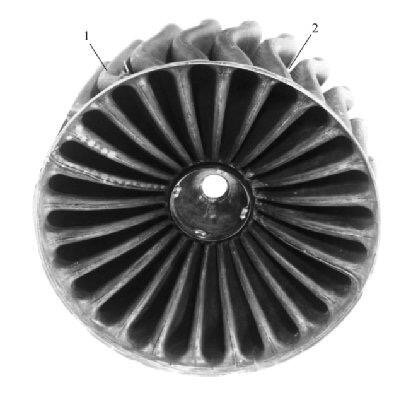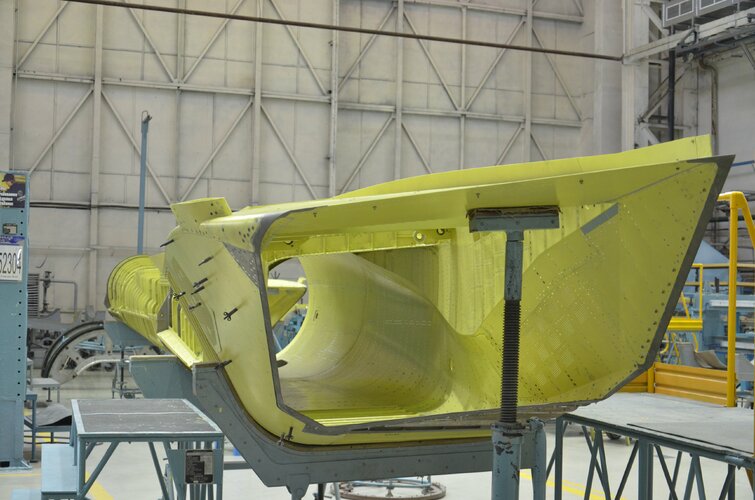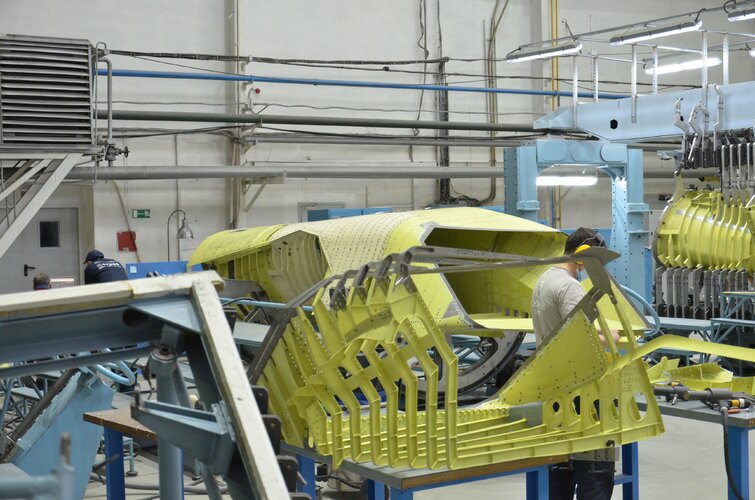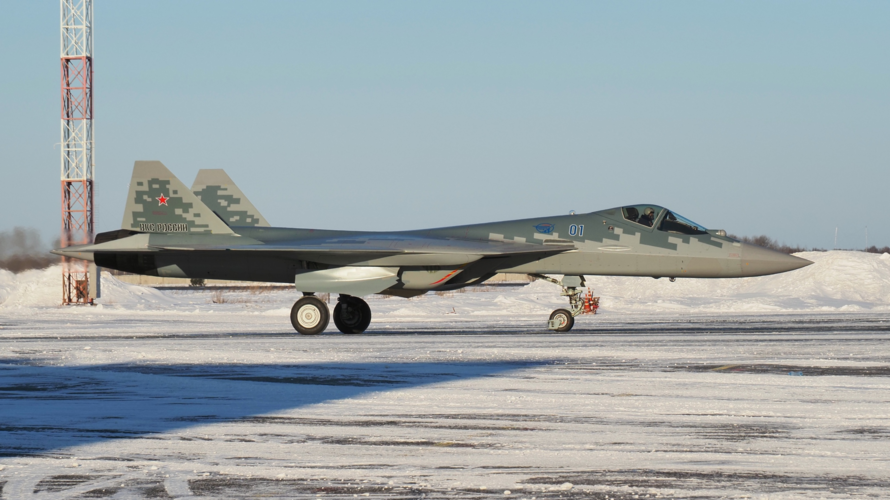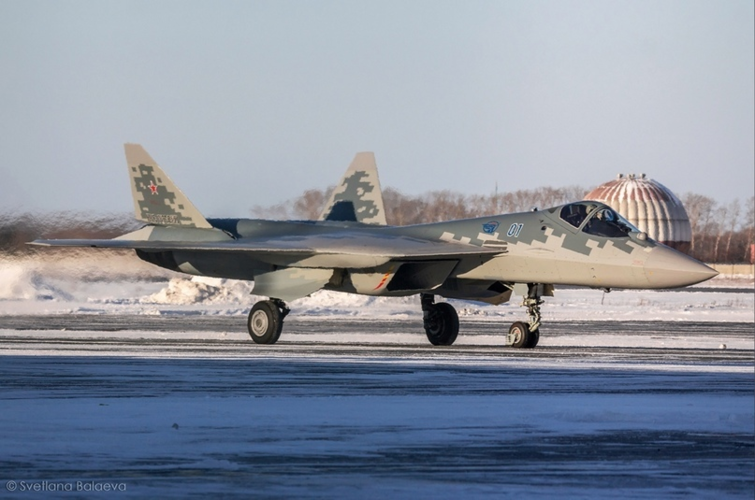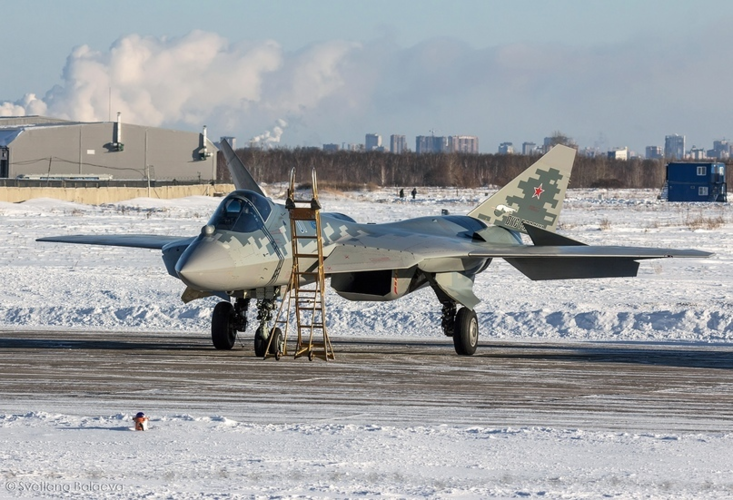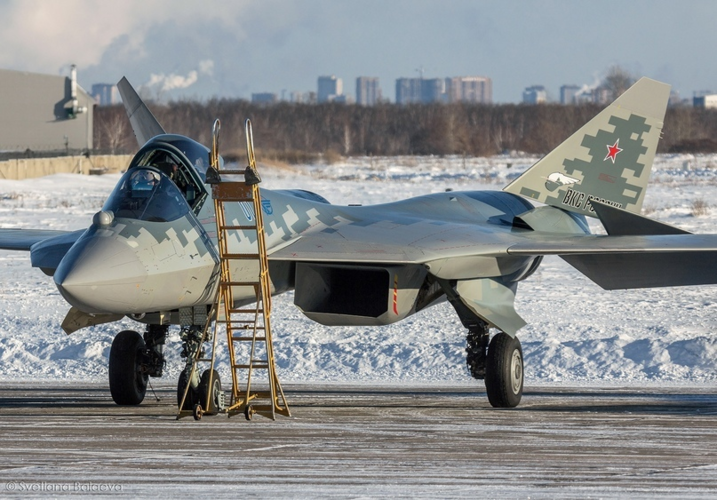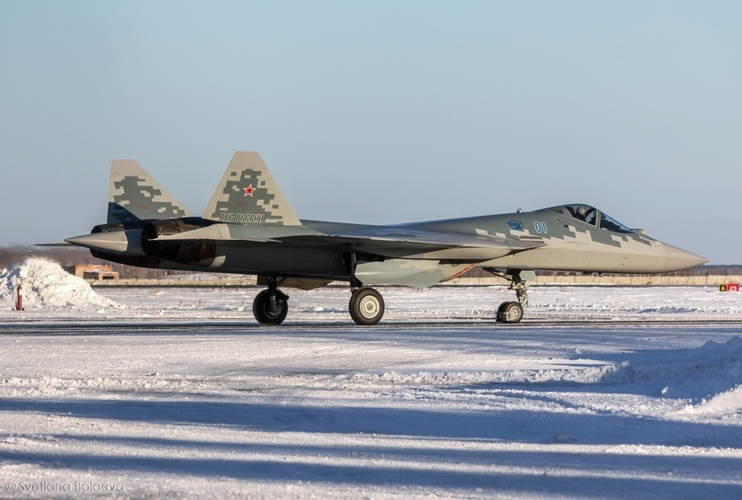You are using an out of date browser. It may not display this or other websites correctly.
You should upgrade or use an alternative browser.
You should upgrade or use an alternative browser.
Sukhoi Su-57 / T-50 / PAK FA - flight testing and development Part II [2012-current]
- Joined
- 11 February 2010
- Messages
- 1,558
- Reaction score
- 2,352
Guess the "real" blocker is behind it. Or maybe that's where the blocker would be attached, ahead of it. The blocker would be at front while that device "straighten" any flow distortion caused by the blocker to provide the engine the air it needs.
Or maybe yes it's the blocker itself, consulting from this patent image

Or maybe yes it's the blocker itself, consulting from this patent image

TSARb
ACCESS: Confidential
- Joined
- 8 March 2011
- Messages
- 52
- Reaction score
- 114
This is the blocker of the next engine called "product 30".why does it look different from this: I thought this is the blocker?
View attachment 645600
And not the real one, but close enough actually.
I see them as faceted DSI bumpsI was actually more interested in the fixed oblique ramps that are in the sides of the inlets now
You were misleaded. Here is a schematic view of PAK FA radar-blocker that was published many years ago. Looks pretty similar to the recent photo, right?why does it look different from this: I thought this is the blocker?
View attachment 645600
Attachments
RadicalDisconnect
Anthony Foulke
- Joined
- 28 April 2014
- Messages
- 192
- Reaction score
- 78
The radar blocker looks quite low loss. I wonder how this system compares to a S-duct.
The S-channel has never been the ideal solution for RCS reduction. This is the simplest solution. Engineers from Northrop and Boeing are not idiots and have relied on blockers. The level of RCS X-32 and YF-23 fully met the requirements of the military. The nonsense about the mandatory use of S-channels on stealth aircraft was invented by stupid and uneducated people.The radar blocker looks quite low loss. I wonder how this system compares to a S-duct.
Attachments
S-channel is not the simplest solution, it is the most effective way to reduce radar signature in the inlet because the shape and length of an S-duct make radar wave bounce of the wall many times before they can coming out of the duct, the longer the duct and the more curvy it is, the more bounce you will have, and as a result, the bigger accumulated radar absorbing capability. A layer of RAM with modest absorbing capability of 5-15 dB can be accumulated to 60 dB even with a slight curved duct. ( 60 dB mean you reduce radar wave power by 1.000.000 times). But an S-channel is lot heavier than a blocker and it can take up valuable space for fuel and weapon bayThe S-channel has never been the ideal solution for RCS reduction. This is the simplest solution. Engineers from Northrop and Boeing are not idiots and have relied on blockers. The level of RCS X-32 and YF-23 fully met the requirements of the military. The nonsense about the mandatory use of S-channels on stealth aircraft was invented by stupid and uneducated people.


Secondly, when radar wave strike an edge, they will be diffracted, this diffraction effect can cause radar wave to scattered in many directions including straight back, the more edges there are, the more diffraction, an inlet blocker has a lot more edges than an S-duct because an S-duct only has the edge on the inlet lips


YF-23 use an S-duct and the F-23 mock up that was used in RCS measurement is F-23EMD which has an additional DSI
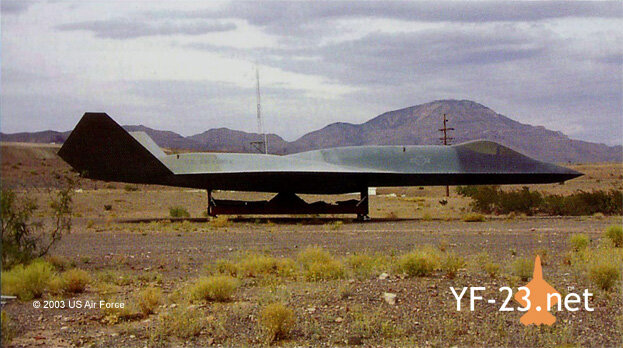
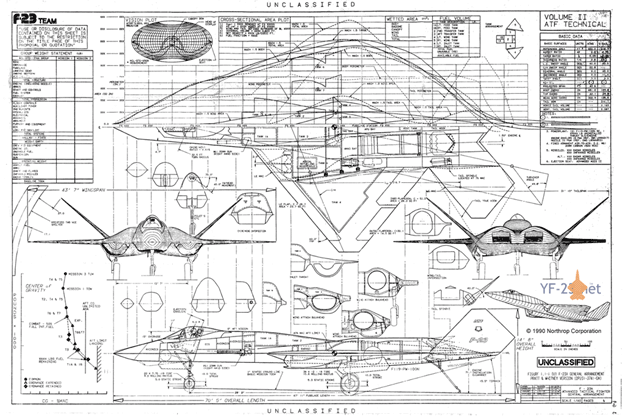
Last edited:
haavarla
ACCESS: Secret
- Joined
- 29 June 2010
- Messages
- 200
- Reaction score
- 252
S-channel is not the simplest solution, it is the most effective way to reduce radar signature in the inlet because the shape and length of an S-duct make radar wave bounce of the wall many times before they can coming out of the duct, the longer the duct and the more curvy it is, the more bounce you will have, and as a result, the bigger accumulated radar absorbing capability. A layer of RAM with modest absorbing capability of 5-15 dB can be accumulated to 60 dB even with a slight curved duct. ( 60 dB mean you reduce radar wave power by 1.000.000 times). But an S-channel is lot heavier than a blocker and it can take up valuable space for fuel and weapon bayThe S-channel has never been the ideal solution for RCS reduction. This is the simplest solution. Engineers from Northrop and Boeing are not idiots and have relied on blockers. The level of RCS X-32 and YF-23 fully met the requirements of the military. The nonsense about the mandatory use of S-channels on stealth aircraft was invented by stupid and uneducated people.


Secondly, when radar wave strike an edge, they will be diffracted, this diffraction effect can cause radar wave to scattered in many directions including straight back, the more edges there are, the more diffraction, an inlet blocker has a lot more edges than an S-duct because an S-duct only has the edge on the inlet lips


YF-23 use an S-duct and the F-23 mock up that was used in RCS measurement is F-23EMD which has an additional DSI
View attachment 645862
View attachment 645863
S-channel is the simplest solution. In YF-23 this is not fully implemented. The X-32 doesn't have one at all. The aircraft fully satisfied the military in terms of RCS. At the same time, it was built 10 years after the YF-23 and F-22. Diffracted is absent when using a composite blocker. Engineers from Boeing are not idiots.
Last edited:
TSARb
ACCESS: Confidential
- Joined
- 8 March 2011
- Messages
- 52
- Reaction score
- 114
S-shaping is the best way to achieve extreme low observability of inlet, because a blocker (even made of RAMs) have it's own radar' reflection too. But that reflection is negligible compared to other parts of LO fighter, like radars, lots of other antennas, surface itself, leading edges of the wing, tails, etc.
Last edited:
QuadroFX
Russia, Chelyabinsk
Last edited:
S- channel isn't the simplest solution, it just the most efficient from signature point of view because it cause the signal to bounce multiple time and accumulate the radar absorbing effect of the RAM layer. Engine face blocker was first used on F-117 ways before S-duct were designed and used on F-22 and F-35. Engine blocker also used on F-18 E/F
S-channel is the simplest solution. In YF-23 this is not fully implemented. The X-32 doesn't have one at all. The aircraft fully satisfied the military in terms of RCS. At the same time, it was built 10 years after the YF-23 and F-22.Engineers from Boeing are not idiots.
YF-23 and F-23EMD both used S-duct, but the one used for RCS evaluation is F-23EMD which has more prominent S-duct and a DSI inlet
Something is built later doesn't automatically mean it is better on all front, X-32 was built 10 years later than YF-22 and YF-23 and it is slower, carry less missile , with smaller radar, less agile .... so on. The point is: they have different requirements.
No one ever said Boeing engineers are stupid, no need to repeat that, it is a strawman argument. S-duct and turbine blocker has their own advantages and disadvantages. Blocker has advantage in lighter weight and smaller volume while S-duct has advantage in signature. You can have two design satisfied the same requirement and yet they can be different. For example: let say your requirement is making a fighter that can fly faster than Mach 1=> F-35 and F-16 can satisfy that but they aren't equally fast.
The whole point of the blocker is to stop radar wave from reaching the turbine blades, if you make them transparent to radar wave then what the point of having them in the first place?Diffracted is absent when using a composite blocker.
Cannonfodder43
ACCESS: Confidential
- Joined
- 8 December 2019
- Messages
- 114
- Reaction score
- 296
It was mentioned that this Radar Blocker may produce a distinct sound.
View: https://www.youtube.com/watch?v=4Way5bhbpLU&ab_channel=KHMedia
At 0:22 and 1:43 there is a very distinct high pitched whine that was not present in other Su-57 Aerobatic showings.
At 0:22 and 1:43 there is a very distinct high pitched whine that was not present in other Su-57 Aerobatic showings.
Cannonfodder43
ACCESS: Confidential
- Joined
- 8 December 2019
- Messages
- 114
- Reaction score
- 296
Yes but hearing it for the first time is certainly interesting. Seeing as how it was never heard until during the Victory Day fly-by apparently.
Bhurki
ACCESS: Secret
- Joined
- 16 July 2020
- Messages
- 345
- Reaction score
- 381
Stuka siren for ww3 (pun intended)It was mentioned that this Radar Blocker may produce a distinct sound.
View: https://www.youtube.com/watch?v=4Way5bhbpLU&ab_channel=KHMedia
At 0:22 and 1:43 there is a very distinct high pitched whine that was not present in other Su-57 Aerobatic showings.
Last edited:
QuadroFX
Russia, Chelyabinsk
Last edited:
QuadroFX
Russia, Chelyabinsk
QuadroFX
Russia, Chelyabinsk
Using augmented reality in Su-57 production line. Part 3
View: https://www.youtube.com/watch?v=oVn5_CARnqs


Don't underestimate the Russians, I have seen a guy on youtube build two houses and a sailboat; the sailboat was enormous and when he finished it looked like he bought it from a factory, incredible stuff. It is like they just get on doing things instead of overthinking things too much.
I believe there will be more videos and photos from the production facility. An action in the public domain to combat the reputation of lower quality than the competition. Well done.
Next comes time to review the overall RCS level of the Su-57. Which I imagine is better.
Next comes time to review the overall RCS level of the Su-57. Which I imagine is better.
QuadroFX
Russia, Chelyabinsk
Are the darker gray parts titanium? I'm surprised how little spars are on the nose section next to the round sensor, I imagine the skin and internal components give it rigidity.Su-57 assembly line
FighterJock
ACCESS: Above Top Secret
- Joined
- 29 October 2007
- Messages
- 5,138
- Reaction score
- 5,073
Are the darker gray parts titanium? I'm surprised how little spars are on the nose section next to the round sensor, I imagine the skin and internal components give it rigidity.Su-57 assembly line
I thought that the dark grey parts were carbon composites? All the YouTube videos that I have watched on the PAK-FA/ Su-57 have stated that the PAK-FA/Su-57 have made great use of carbon composites over the previous generation such as the MiG-29/Su-27.
I thought the light grey on the skin was carbon composite, yellow aluminium, and dark titanium, for example where the exhaust goes next to the tail stinger. Is that coorect? Inside the engine, compartments look like dark grey.
I thought the light grey on the skin was carbon composite, yellow aluminium, and dark titanium, for example where the exhaust goes next to the tail stinger. Is that coorect? Inside the engine, compartments look like dark grey.
That sounds about right. Many of the light grey panels have been displayed separately as composite parts, so we know what they're made of.
BLACK_MAMBA
ACCESS: Secret
- Joined
- 17 July 2019
- Messages
- 377
- Reaction score
- 858
Do no photos exist yet of 02 or was 02 renumbered 01 after the original 01 crashed?
Ainen
I really should change my personal text
- Joined
- 25 August 2011
- Messages
- 800
- Reaction score
- 946
It's a new one.(i. e. fresh photos)Do no photos exist yet of 02 or was 02 renumbered 01 after the original 01 crashed?
- Joined
- 11 February 2010
- Messages
- 1,558
- Reaction score
- 2,352
Congrats for the 2nd production example. Guess this is the first Russian serial production fighter with AESA's.
Is it shure the production prototype? It has not the new shaped noseView attachment 647101
First serial.
View attachment 647102
View attachment 647103
View attachment 647104
View attachment 647105
View attachment 647107
(For some reason spoiler function just laughted in my face)
BLACK_MAMBA
ACCESS: Secret
- Joined
- 17 July 2019
- Messages
- 377
- Reaction score
- 858
That was simply a placeholder cover nose lacking the sharp corners as seen on this aircraft and the prototypes.Is it shure the production prototype? It has not the new shaped nose
The winner of the youth competition "The Future of Aviation" held by PJSC UAC was the project of the branch of PJSC Sukhoi Company "KnAAZ im. Yu.A. Gagarin "Implementation of Augmented Reality in Aircraft Industry", presented by Lead Programmer Valery Timokhin, Software Engineers Roman Zalata and Valentina Nikitina.
and serial number:52201
and serial number:52201
Similar threads
-
Sukhoi PAK FA news and speculation (T-50, I-21) Part II [2008-2009]
- Started by overscan (PaulMM)
- Replies: 451
-
Sukhoi Su-57 / T-50 / PAK FA first flight - pictures, videos and analysis [2010]
- Started by flateric
- Replies: 872
-
Sukhoi Su-57 / T-50 / PAK FA - flight testing and development Part I [2010-2012]
- Started by Matej
- Replies: 760
-
Sukhoi PAK FA news and speculation (T-50, I-21) Part I [2006-2008]
- Started by overscan (PaulMM)
- Replies: 455
-
Vladimir Sergeevich Ilyushin 31-03-1927 - 01-03-2010
- Started by flateric
- Replies: 4

